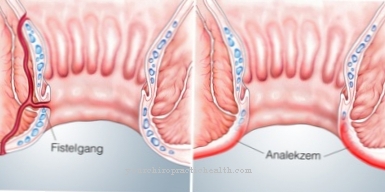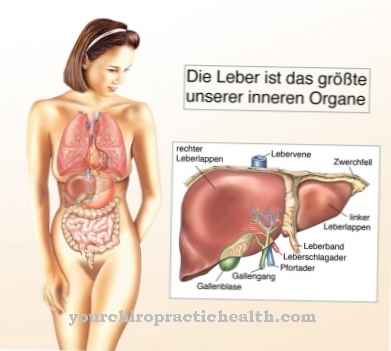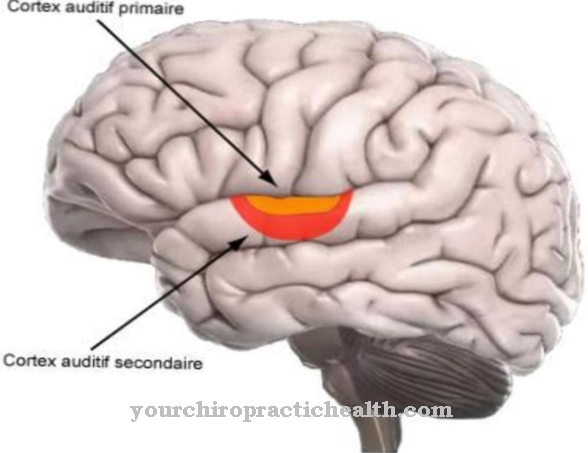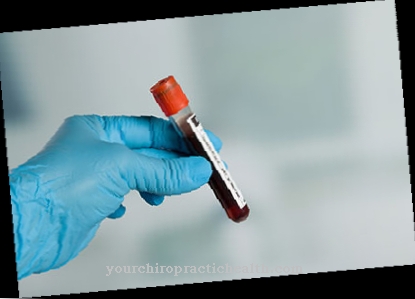As Aortic regurgitation is an insufficiency of the aortic valve in the left ventricle. Part of the aortic blood can flow back during the relaxation phase of the chamber, which, depending on the degree of severity, has long-term effects on the heart and the entire cardiovascular system.
What is aortic regurgitation?

© elvira fair - stock.adobe.com
A leak in the aortic valve, which acts as a valve between the left ventricle and the aorta, the body's main artery, is called Aortic regurgitation or better called aortic regurgitation. During the systolic contraction phase of the heart chamber, the aortic valve opens and clears the way for the oxygen-enriched blood from the pulmonary circulation.
The aortic valve is designed as a so-called pocket valve with three pockets that fill with blood after the pressure phase has ended and virtually close the aorta, so that no blood can flow back from the aorta into the left chamber during the relaxation phase of the chambers (diastole). If the aortic valve does not close completely and more than 15% of the blood pumped into the aorta flows back, aortic valve regurgitation is present.
causes
The most common cause of aortic valve insufficiency is a direct bacterial infection of the valve tissue (endocarditis) or a previous streptococcal infection, which can trigger rheumatic fever and spread to the heart valves. Once the infection has been overcome, scarring can occur on the pockets of the aortic valve, which can then no longer close tightly.
The venereal disease syphilis used to present a serious problem, as it can also spread to the heart valve tissue and cause valve insufficiency. Despite the possibility of treatment with antibiotics, the disease is on the rise again. In rarer cases, certain gene mutations also play a role, such as in Marfan syndrome. The gene mutations, which occur spontaneously in up to 40 percent of the cases, in this case not inherited, lead to disorders in the structure of the connective tissue.
In some cases, incorrect positioning of the aortic valve plays a role. It can happen that only two pockets instead of three are formed in the aortic valve, which is not noticeable at first, but favors later insufficiency. Further factors are an overstretching of the aortic root or the ascending branch of the aorta or an aortic dissection, in which the inner wall of the aorta becomes detached and blood penetrates into the intermediate area of the aortic walls.
Symptoms, ailments & signs
Lighter forms of aortic valve insufficiency, in which the backflow of blood makes up less than 20 percent of the blood squeezed out of the left ventricle, are almost asymptomatic and go unnoticed by those affected. In more severe forms of insufficiency, there is initially a high amplitude of blood pressure with, as a rule, very low diastolic pressure.
The next signs of a possibly existing aortic valve insufficiency are noticeable physical performance losses with increasing shortness of breath and cardiac arrhythmias, which can trigger occasional fainting attacks. If the insufficiency has persisted for a longer period of time, a backlog in the lungs and veins gradually sets in.
Water accumulates in body tissue and especially in the legs. Further symptoms are a so-called water hammer pulse, a rapid, strong pulse that is based on very high blood pressure amplitudes of sometimes over 100 mmHg. Usually extrasystoles are also noticeable. In the case of untreated aortic valve insufficiency, an unconscious nod of the head to the rhythm of the pulse may occur.
Diagnosis & course
There are a number of diagnostic options for determining aortic valve insufficiency. The first method of choice is auscultation because the insufficiency is noticeable by a typical diastolic sound (Austin-Flint sound). It is a rumbling noise that is clearly audible from about mid-diastole to the onset of systole.
Other diagnostic options include EKG, ultrasound, phonocardiography, X-rays and cardiac catheter examinations. If left untreated, the insufficiency can gradually lead to a widening (dilation) of the left ventricle and to a thickening of the outer heart muscle (eccentric hypertrophy).
These physiological compensatory measures result in an increased oxygen requirement of the heart muscle and a decrease in performance, so that heart failure occurs. If left untreated, the course of the disease can lead to loss of physical performance and gradual changes in the left ventricle and heart muscles to life-threatening conditions.
Complications
Complications that arise due to untreated aortic valve insufficiency are based on an insufficient supply of the entire body with oxygen-rich, arterial blood. This also includes the central nervous system. Due to the leakage of the aortic valve, part of the blood that was pumped from the left ventricle into the aorta during systole flows back during diastole.
As a result, it mixes with blood, which also flows from the left atrium into the left ventricle during this phase. The accompanying complications depend very much on the degree of leakage or the amount of blood reflux. If the reflux is less than 20 percent of the originally pressed volume, there are hardly any symptoms or complications.
In the case of higher-grade insufficiencies, complications such as loss of performance, shortness of breath, brief fainting spells after exercise, and often cardiac arrhythmias in the form of frequent extrasystoles or atrial fibrillation arise. If the aortic valve regurgitation persists for a longer period of time, there are additional complications. The left ventricle can expand and because the heart wants to compensate for the shortage of supply, the ventricular muscles of the left ventricle gradually thicken.
The compensatory measure ultimately leads to heart failure, which in turn can cause further complications such as water retention in the lower extremities and severe loss of performance, as well as congestion in the veins. The life-threatening conditions that arise in the further course of the disease can be avoided as far as possible through early treatment.
When should you go to the doctor?
In the worst case, aortic valve insufficiency can lead to the death of the patient and must therefore under no circumstances be left untreated. The symptoms cannot be felt directly in the heart, but are usually expressed through other restrictions in everyday life. Usually these are not particularly characteristic of the disease.
However, a doctor should always be consulted if you have heart problems or if you feel weak. A medical examination is particularly necessary if you experience difficulty breathing. If the person concerned is also suffering from loss of consciousness and an increased heart rate, these symptoms can also indicate aortic valve insufficiency and should be examined.
Heart problems often lead to accumulations of water in different regions of the body. If the patient should therefore notice these accumulations, a doctor must also be consulted so that there is no consequential damage or death of the patient. In many cases, an unconscious nod of the head also indicates aortic valve insufficiency. Even if you are generally tired, exhausted and have a reduced resilience that occurs for no particular reason, a medical examination is definitely required.
Doctors & therapists in your area
Treatment & Therapy
With asymptomatic low blood return of less than 20 percent of the pumped blood, no treatment is necessary, but regular monitoring is necessary so that measures can be initiated in good time if necessary. If an incipient dilatation of the left ventricle and a thickening of the wall musculature become apparent, an operative repair or an operative replacement of the aortic valve is necessary.
A number of options are available for this. Open-heart surgery can be performed or, in certain cases, even minimally invasive via catheters. Basically - depending on the initial situation - there are options to change the leaky heart valve surgically so that it can perform its function again or that it is replaced by an artificial heart valve made of plastic or biological tissue.
Outlook & forecast
The aortic valve insufficiency can be classified as good with today's medical possibilities. Some patients do not require any further therapeutic measures for their entire life, as they are able to lead an adequate life with the aortic valve insufficiency.
You experience restrictions or prohibitions, but the warning notices often move outside the comfort zone and thus do not lead to any real impairment. In addition to regular check-ups, the sick may perceive themselves to be very healthy and have adapted their lifestyle to the circumstances.
Patients in need of medical care also have good prospects of recovery. The heart valve is corrected in a surgical procedure so that the heart's activity is then fully functional again. The procedure is now very routine and can be completed within a few hours. After a few days, the patient is usually discharged from the hospital. After an appropriate closed season, he can participate in normal life again as usual and manage his everyday life independently.
Nevertheless, despite the positive outlook, the risks and side effects of an operation under general anesthesia must of course be taken into account. Good wound care is also essential for the healing process. After the operation, the patient has the task of incorporating precautionary measures and health-endangering restrictions into his everyday life. Sports activities must be adapted and extreme situations must be avoided so as not to cause overexertion.
prevention
There are no known preventive measures that could effectively prevent aortic regurgitation. Only the treatment of essential high blood pressure can also be rated as a preventive measure, because the high blood pressure favors the development of insufficiency.
If, however, an aortic valve insufficiency has been found that does not affect the person affected, a regular check of the wall thickness and volume of the left ventricle is recommended as a preventive measure, so that an operative measure can be carried out in good time before irreparable secondary damage occurs.
Aftercare
Follow-up care options are severely limited in the case of aortic valve insufficiency. In most cases, the patient is primarily dependent on treatment by a doctor so that there is no reduced life expectancy or a sudden stop of the heart. The earlier the aortic valve regurgitation is recognized, the higher the probability of a positive course of the disease.
In most cases, aortic valve regurgitation requires the patient to have surgery. Only then can the valve be repaired or replaced so that the heart can work again. The operation usually proceeds without complications and allows the person affected to live a symptom-free life.
After the surgery, the patient should rest and not engage in strenuous or physical activity. In general, unnecessary strain on the body or other stressful situations should be avoided in order not to strain the heart unnecessarily.
A healthy lifestyle can have a positive effect on the further course of the disease, whereby the person concerned should pay particular attention to a healthy diet. A doctor should also be consulted immediately at the first signs of aortic valve insufficiency.
You can do that yourself
A necessary adaptation of behavior in everyday life to aortic valve insufficiency depends on the severity of the insufficiency. The degree of severity can reach levels I (mild) to IV (severe). The assignment of the insufficiency to one of the four degrees of severity depends on the proportionate amount of blood backflow into the left ventricle during the relaxation phase of the ventricles (diastole).
While stages III and IV usually require reconstructive interventions or the replacement of the heart valve to improve survivability and improve the living situation, in the lighter forms significant improvements in well-being can be achieved through adaptation of behavior and self-help measures.It is not known whether this can also influence the course of the disease. It almost goes without saying that the self-help measures also include severe restrictions on tobacco and alcohol consumption.
The most important part, however, is exercise and active sports. Sports that do not require uncontrollable top performance are best suited. Therefore, sports such as swimming, hiking, Nordic walking and kayaking as well as golfing on flat terrain are well suited. Most ball sports such as tennis, soccer, and handball are not considered self-help measures.
A balanced diet is also important to strengthen the immune system and avoid stressful situations that are too frequent. Relaxation techniques such as yoga, meditation, and autogenic training are recommended.






.jpg)









.jpg)







.jpg)



